More Push
DE
EN
Souping-Recipes
Of course You cannot perform magic tricks with physics and You may not expect miracles, but the little 25HP- or else 36HP engine is a rewarding candidate for tuning and the extra push which can be achieved is, compared to the original output, remarkable.
Due to this, the thermal load of the tuned engine is significantly higher than with the “pedal to the metal” proof stock motor. Now it´s to the driver, how long the pleasure about the “souped” machine will last.
For this reason we recommend fitting an oil-temperature gauge!
This definately is worth the investment, who in addition fits an oil-pressure gauge will, to our experience, in many cases recon even earlier, if it gets “do or die” for the little compagnion in the back.
All “Souping”-Recipes given here have been performed and tried out during the last 40 years of our Volkswagen time. Thereby we used all our `50s Beetles as every day drivers, most of the time as the only ride we owned. All together there are some 100K miles with driving tuned 1950s Beetles.
We here skip such things as the correct valve lash-, carburetor- or ignition-adjustment. It´s clear that an engine that You expect to perform the most output possible has to be perfectly maintained and adjusted.
And now to practice:
1. Cooling Fan and Fan-Speed
It´s obvious that the cooling fan needs driving power. This power indeed is significant, it increases about with square of the fan speed and averages about 6 to 8HP at the nominal speed of 3.400RPM with the stock 36HP engine.
On the other hand, as fan speed increases the volumetric flow rate don´t rises proportionate, it approaches a limit value.
Of course, the VW cooling fan is perfectly tuned to the stock engine speed, but the higher revs of the “souped” machine worsens fan efficiency. So, it´s a good idea to slow down the cooling fans speed.
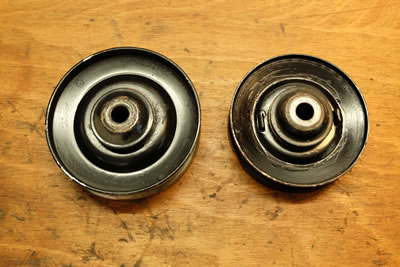
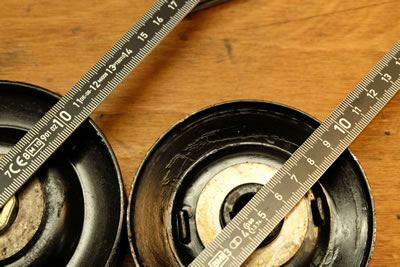
Pulley diameter
An additional advantage of the lower fan drive ratio is, that the extra power necessary to drive the fan at higher speed now finds it´s way to the clutch.
In practice:
You stay with the stock fan with 16 blades (Porsche 356 fan has 28 blades), but the stock fan- / dynamo-pulley is replaced by the larger pulley of the VW 1600cc / 50HP engine. Thus volumetric flow increases more slowly and the best flow rate (as with nominal speed of the stock engine) is achieved at the higher speed of the “souped” engine.
Tests with a 1954 Beetle showed the following Oil temperatures at 25°C environmental temperature:
- Stock 36HP engine w. stock fan speed:
80Km/h / 65°C - 100Km/h / 90°C - 110Km/h / 110°C - Stock 36HP engine w. lowered fan speed:
80Km/h / 75°C - 100Km/h / 100°C - 110Km/h / 110°C - 36HP engine w. 28PCI Speed Rex dual carbs, stock fan speed:
80Km/h / 65°C - 100Km/h / 90°C - 110Km/h / 110°C - 120Km/h / 115°C - 36HP engine w. 28PCI Speed Rex dual carbs, lowered fan speed:
80Km/h / 75°C - 100Km/h / 100°C - 110Km/h / 110°C - 120Km/h / 120°C - 36HP engine w. Judson Supercharger, 28PCI carb, stock fan speed:
80Km/h / 75°C - 100Km/h / 105°C - 110Km/h / 115°C - 120Km/h / 125°C - 36HP engine w. Judson Supercharger, 28PCI carb, lowered fan speed:
80Km/h / 80°C - 100Km/h / 110°C - 110Km/h / 120°C - 120Km/h / 130°C - 36HP engine w. MP / AMR500 Supercharger, stock fan speed:
80Km/h / 70°C - 100Km/h / 90°C - 110Km/h / 100°C - 135Km/h / 110°C - 36HP engine w. MP / AMR500 Supercharger, lowered fan speed:
80Km/h / 75°C - 100Km/h / 95°C - 110Km/h / 105°C - 135Km/h / 115°C
In combination with the stock crankshaft pulley needed V-belt size is 9.5 x 913outer length.
2. Air Cleaner
Replacing the stock Oil-bath air cleaner of the late 25HP and 36HP engines by a so called “Wet Mesh Air Cleaner”, for example a Mushroom air cleaner from an industrial or early VW engine (steel mesh filter, not wood wool mesh as on some industrial engines) or an Okrasa Knecht Filter, showed during tests on our Schenck dynamometer an output increase of 3HP at 3,500RPM.
With a “souped” engine You usually will use “Wet Mesh Air Cleaners”, here, using Oil-bath air cleaners instead will result in loss of power.
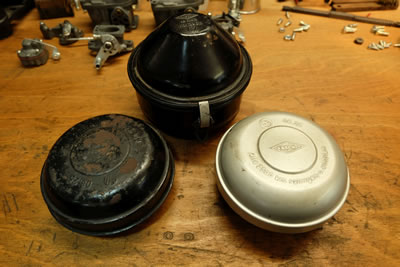
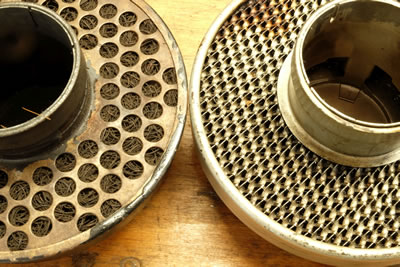
Air cleaner
With the single 28PCI carb engine the stock 117.5 Main Jet should be replaced by a jet of 120 or 122.5 size, otherwise the open air cleaner may cause a too lean mixture at full throttle.
Needless to say that a “Wet Mesh Air Cleaner” has to be maintained by washing and re-oiling every 2.500Km / 1.500mls to keep the filter rate adequate
Too it results in a little higher intake sound.
3. Cam Follower Shape
A simple method to get “more push” from the 25HP- or 36HP engine is a change of the cam follower´s shape. On the single carb engine with it´s narrow “stag´s antlers” intake, the power increases just a little, on the multi-carb- or supercharged engine power rises quite good noticeable.
The 25HP- and 36HP engines are using cam followers wit a spherical face in combination with an appropriate cam profile. This profile has faster opening and closing sections than cams designed for flat follower face.
Thus, a flat cam follower face combined with cam designed for spherical face followers results in faster opening and closing of the valves. Valve duration remains nearly the same as with spherical followers, but the mean valve gap during the intake- or exhaust-period gets larger.
To Practice:
On the 25HP- and 36HP engines the cam followers with their pushrods can be extracted after removing the rocker assemblies, it´s not necessary to take the crankcase appart
.
Then the spherical face of the cam followers is grinded to a flat shape, this must be done on a cylindrical grinding machine. Remove as much material as necessary and as few material as possible, a small rest area of the spherical shape at the edge of the followers (0.5mm to 1mm) may remain.
A tool grinding shop is equipped with the needed machines to do the job.

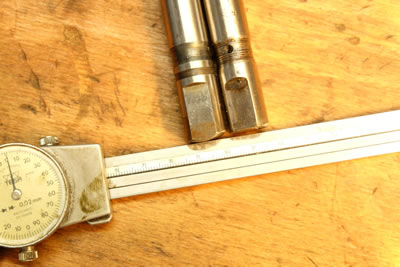
Cam Follower Shape
Of course, stress of the complete valve train rises, this results especially in higher wear of the new follower face with a now smaller hardening depth. After about 7K miles a small groove accrues in the middle of the flat follower-face, we then replace the followers and pushrods.
To our experience the cams seem not to have excessive wear with flat cam followers, may be this is a result of the early replacing of worn followers.
The extra power You get by this recipe is felt over the complete revving range, we did no dynamometer runs yet, but it feels like about 4HP more with a dual carb Riechert Speed Rex engine, a supercharged motor at 0.4bar / 5psi boost will get about 7HP more from flat cam followers.
4. Intake Manifold Length
Except the “Okrasa” dual carburetor setup, nearly all other dual- or four-carb installations are using relatively short intake manifolds. To achieve a reasonable oscillating forced induction in the rev- range of the “souped” 25HP or 36HP engine, these manifolds are much too short.
Oscillating forced induction is generated, when the mixture underneath the intake throat, pressurized by it´s velocity and inertia, that runs down the manifold arrives at the intake valve just when it opens.
Calculation of the ideal intake manifold length, You here and there may find practical formulae, gives a distance of about 450mm / 18inch between carburetor throat and intake valve for the usual dual-carb manifold width of the 1200cc VW engine installations.
On a 36HP engine with stock camshaft in combination with flat cam-follower-faces and a Riechert Speed Rex dual 28PCI carburetor setup, we tried out 100mm / 4inch long flanged tubes, bolted between carburetor and manifold.
A gain in torque could be recognized over the complete rev range worth the little effort.
With such flanged tubes as manifold extension it too is possible to adopt 32- or 34PCI carbs to the 28PCI dual-carb intakes. The necessarily tapered design results in addition to an accelerated mixture, which aids the forced induction during valve-timing-overlap.
Info
Sie intersessieren sich für unsere Produkte?
Nachdem Sie die Anfrage versendet haben, prüfen wir ob die Produkte in Ihrem Warenkorb vorrätig sind und schicken Ihnen ein Angebot.